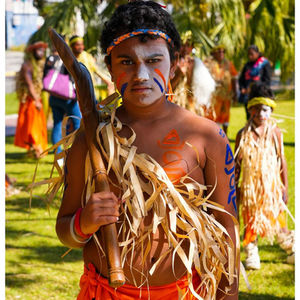BOÉA PROVIEDANSE
Everyone knows New Caledonia but very little about the Kanak people, their culture, their origins and the artistic richness of their painting, sculpture, music or architecture that they have managed to preserve or develop throughout its history.
Geographically, New Caledonia is the archipelago closest to Australia in the heart of the Coral Sea. This territory consists of the Grande Terre whose capital is Nouméa and a series of archipelagos located on its sides, including the island of Lifou which is part of the Loyalty Islands. This mountainous archipelago leads to the coral sea through a wide and superb area of shoals that form a coral reef. It is humid as a whole, which gives it a richness of vegetation sometimes exuberant.
The history of New Caledonia begins with the successive waves of settlements coming from the northeast, starting from 2,500 before Christ. Potteries and petroglyphs testify to the existence of the first inhabitants of the archipelago. Between the 12th and 17th centuries, Polynesian navigators from the east on dugout canoes docked at the Loyalty Islands. It was in 1744 that she was discovered by the English navigator James COOK before she changed hands to become French in 1853.
From this story, there is a Kanake identity that the folk ensemble 'Boea Proviedanse' illustrates with a strong culture, which it expresses with a well-living talent. And this is the role of all the small islands like that of Lifou, more than that of Grande Terre where the New Caledonians are more numerous. The richness of this culture is discovered with patience. It is rich in its myths, based on complex ceremonial exchanges. The Kanak people dispersed on a crowd of sometimes tiny islets, thus preserve their gods, their cosmogony, their organization of the ground and the sky, their knowledge which are transmitted from generation to generation, from elders or chiefs. Their language is complex. The vigour of customary tribes is based on the notion of a village whose chieftainships are par excellence living memories.
You will be surprised by the strangeness of this folk ensemble, its costumes, its symbolic weapons, its music, its songs and its dignity. He defends a culture of which he is totally impregnated and that ancient or modern events have never succeeded in erasing. He is aware of playing an initiating and respectable role in relation to the past. The nations of the South Pacific wish to remind the world that their ocean is populated by men who probably came from Asia in pirogues, bearers of a rich civilization and that they base their future on a return to custom.
Under our eyes interested, surprised or passionate by this rebirth and this discovery of a universe exploded but not adrift, the show of the folk Ensemble "Boea Proviedanse" of New Caledonia will constitute an authentic astonishment.














